
The Commonwealth War Graves Commission (CWGC) is an intergovernmental organisation of six independent member states whose principal function is to mark, record and maintain the graves and places of commemoration of Commonwealth of Nations military service members who died in the two World Wars. The commission is also responsible for commemorating Commonwealth civilians who died as a result of enemy action during the Second World War. The commission was founded by Sir Fabian Ware and constituted through royal charter in 1917 as the Imperial War Graves Commission. The change to the present name took place in 1960.
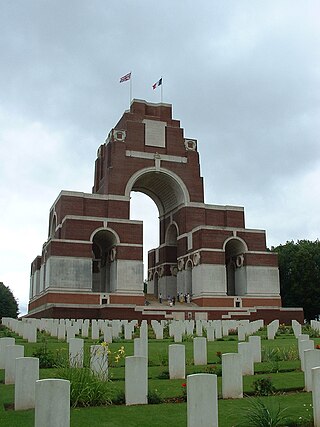
The Thiepval Memorial to the Missing of the Somme is a war memorial to 72,337 missing British and South African servicemen who died in the Battles of the Somme of the First World War between 1915 and 1918, with no known grave. It is near the village of Thiepval, Picardy in France. A visitors' centre opened in 2004. Designed by Sir Edwin Lutyens, Thiepval has been described as "the greatest executed British work of monumental architecture of the twentieth century".

Fromelles is a commune in the Nord department in northern France. As of 2019 it had a population of 1,041; its inhabitants are called Fromellois. It is located about 16 kilometres (10 mi) to the west of Lille.
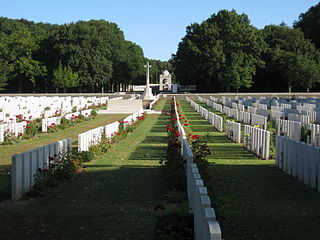
Delville Wood Cemetery is a Commonwealth War Graves Commission cemetery located near Longueval, France and the third largest in the Somme battlefield area.
Devonshire Cemetery is a small Commonwealth War Graves Commission (CWGC) burial site for some of the British Empire and Commonwealth troops killed during the Battle of the Somme. It is located near to the village of Mametz. The cemetery grounds were assigned to the British Empire in perpetuity by the French state in recognition of the sacrifices made by the Allies in the defence of France during the First World War.
The German War Graves Commission is responsible for the maintenance and upkeep of German war graves in Europe and North Africa. Its objectives are acquisition, maintenance and care of German war graves; tending to next of kin; youth and educational work; and preservation of the memory to the sacrifices of war and despotism. Former head of the Bundeswehr Wolfgang Schneiderhan was elected President of the organisation in 2016, succeeding SPD politician Markus Meckel. The President of Germany, currently Frank-Walter Steinmeier (SPD), is the organisation's patron.
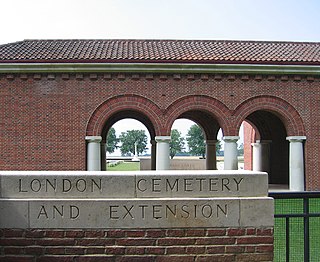
The London Cemetery and Extension is a Commonwealth War Graves Commission cemetery at High Wood near Longueval, France. It is the third largest of the Somme battlefield cemeteries, containing 3,872 World War I burials.
Adanac Military Cemetery is a Commonwealth War Graves Commission burial ground for the dead of World War I located near the French villages of Miraumont, Pys and Courcelette and contains 3,187 interments, 1483 of whom are identified.

The Pozières Memorial is a World War I memorial, located near the commune of Pozières, in the Somme department of France, and unveiled in August 1930. It lists the names of 14,657 British and South African soldiers of the Fifth and Fourth Armies with no known grave who were killed between 21 March 1918 and 7 August 1918, during the German advance known as the Spring Offensive, and the period of Allied consolidation and recovery that followed. The final date is determined by the start of the period known as the Advance to Victory on 8 August.
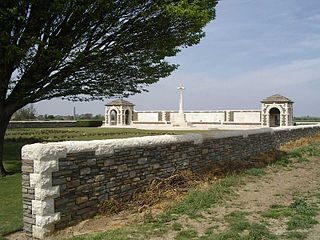
The V.C. Corner Australian Cemetery and Memorial is a Commonwealth War Graves Commission (CWGC) World War I cemetery and memorial. It is in the commune of Fromelles, in the Nord departement of France, about 2 kilometres (1.2 mi) northwest of the village of Fromelles on the D22C road (rue Delval).

Hangard Wood is a locality south of Villers-Bretonneux northern France. It was the site of Hangard village and a battle in World War I. The battle of Hangard Wood was part of the German offensive Operation Michael, in the Arras–Saint-Quentin–La Fère sector of the Somme fought in March 1918. The battle of Hangard Wood was more specifically part of the larger Second Battle of Villers-Bretonneux, fought between the Canadian, British, Australian and French armies on one side and the German army on the other.
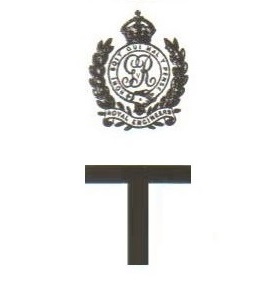
The 178th Tunnelling Company was one of the tunnelling companies of the Royal Engineers created by the British Army during World War I. The tunnelling units were occupied in offensive and defensive mining involving the placing and maintaining of mines under enemy lines, as well as other underground work such as the construction of deep dugouts for troop accommodation, the digging of subways, saps, cable trenches and underground chambers for signals and medical services.

On the morning of 1 July 1916, the first day of the Battle of the Somme during World War I, underground explosive charges planted by British tunnelling units were detonated beneath the German front lines. The joint explosion of these mines ranks among the largest artificial non-nuclear explosions.

Abbeville Communal Cemetery is a Commonwealth War Graves Commission burial ground for the dead of the First World War and Second World War located near Abbeville, in the Somme department of France. It is adjacent to the Abbeville Communal Cemetery Extension.
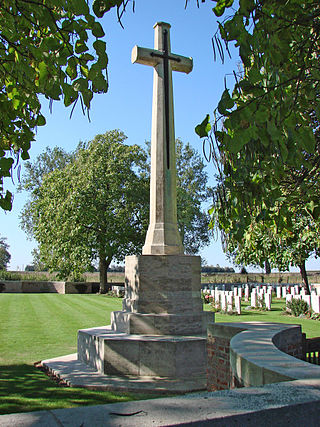
Foncquevillers Military Cemetery is a Commonwealth War Graves Commission burial ground for military personnel who died on the Western Front during the First World War. It is located in the Pas de Calais region of France. Originally established in 1915 by the French military for its soldiers, it was later used for British personnel. Designed by Sir Reginald Blomfield and administered by the Commonwealth War Graves Commission (CWGC), there are 648 soldiers of the First World War interred in the cemetery with 53 of them unidentified. Another four graves are for German soldiers of the First World War, while five Canadian airmen who died in the Second World War and a French civilian are also buried in the cemetery.

The Acheux British Cemetery is a World War I military cemetery located in the French Commune of Acheux-en-Amiénois in the Somme Region.

The Cerisy-Gailly French National Commonwealth War Graves Commission Cemetery is a military cemetery located in the Somme region of France commemorating French, British, and Commonwealth soldiers who fought in World War I. The cemetery contains mostly soldiers who died fighting in the Battle of the Somme and manning the front line near the villages of Cerisy and Gailly between May 1917 and August 1918. The cemetery is managed by the Commonwealth War Graves Commission.
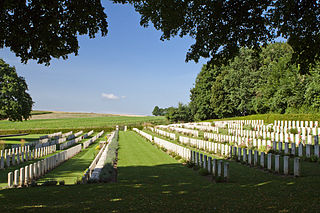
The Contay British Commonwealth War Graves Commission Cemetery is a war cemetery in the Somme region of France, near Franvillers. Located in the cemetery are 1133 deceased, First World War Casualties. Designed by Sir Reginald Blomfield, it mainly holds dead from the Battle of Somme. It is maintained by The Commonwealth War Graves Commission.















